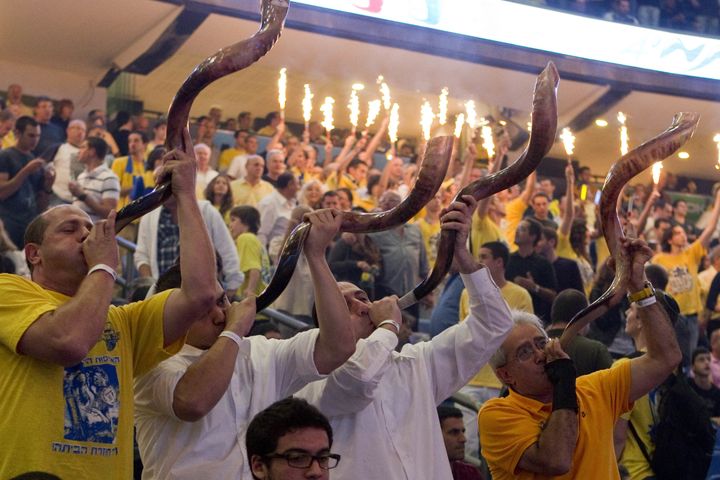
Last week, I was delighted to receive a beautiful and creative virtual Rosh Hashana greeting card consisting of footage of people blowing Shofar around the world. A product of a new project called Art Kibbutz NYC, this "Shofar FlashMob" depicted a glorious gathering of Jews the world over in celebration of the coming Jewish New Year. Included in this greeting card were Shofar blowers from Budapest, New York, Las Vegas, Chicago, San Francisco and other cities. There were adults and small children. The sight brought a smile to my lips.
I forwarded the greeting card to family and friends, bearing in mind that some of the recipients would have to exercise caution about sharing this card with their "noise-sensitive" children.
As the executive director of an organization that works with families of children with special needs, I am only too aware that the excitement and hubbub created by the Jewish holidays are often overwhelming for children with special needs... unless they are prepared ahead of time.
With its evocative, ancient sound, the Shofar can terrify such a child unless an adult -- a parent or educator -- first introduces the concept. This year, for the first time, our organization, Gateways: Access to Jewish Education, prepared a set of specialized downloadable High Holiday Resources to maximize the experience of the holiday and all of its rituals, One of these resources is designed specifically to help children "make friends" with the Shofar.
Utilizing the structure of a social story, "What to Do if the Shofar Sounds Too Loud" we explain what the Shofar is and describe the different kinds of Shofar blasts. This story is helpful for children who are anxious about attending synagogue services because it lets them know what to expect. Many children with disabilities are sensitive to loud noises. This story reassures children that loud noises are safe. It also gives children useful suggestions about what to do if the noise makes them feel scared or uncomfortable.
While promoting our High Holiday resources is certainly a priority for us, what we are really about is promoting a new consciousness about what the 21st Jewish community ought to look like.
This can be summed up in a single word: Inclusivity.
This objective is important to us not only because of our mission, which is to educate children with special learning needs but because it is an inherently Jewish concept, based on the belief that all of humankind is created b'tzelem Elohim -- the Image of G-d.
Rabbi Ora Horn Prouser, academic dean of the Academy of Jewish Religion in New York wrote an important column last month in the New York Jewish Week about the opening chapter of the book of Deuteronomy, which we read at this time of year. In the column, she wrote about Moses, who is speech-impaired, gaining the ability to master speech and channel the word of G-d by receiving the Ten Commandments, which in Hebrew is Aseret Ha-Dibrot, literally, the Ten Words.
In her column entitled, "Moses Finds His Voice," Rabbi Horn Prouser writes:
Moses did not simply lead the Israelites through the desert. This period was one of internal growth for him, as well. He was given the opportunity to grow and develop from someone who did not trust in his own voice, to one who was able to deliver a complicated and controversial speech to his community.
As any parent or educator knows, the ability to find one's voice is one of the central tasks of child development. Every small achievement is a huge milestone, ever more so when it comes to children with special needs.
How monumental it is for us when a child with a disability finds her own voice! And how beautiful to the ear!
Yet as one who is immersed in the field of special education, I am familiar with the sounds of children with special needs, so much so, in fact, that I sometimes forget that what sounds to me like typical speech is, in fact, unusual to those who stand outside of the special needs community.
But I am being cautious or perhaps overly diplomatic in my word choice. When I say "unusual" I actually mean "jarring" -- just like the sound of the Shofar.
And just as the Shofar is meant to awaken our consciousness to introspect, the sounds of children with special needs in our community serve as a wake-up call.
Like all Jewish children, the students served by Gateways look forward to attending synagogue with their parents, siblings and friends. They look forward to singing the Rosh Hashana songs they know. Their inimitable voices will blend in with those of their fellow congregants -- young and old, neurotypical and special needs, female and male -- to form a prayer of special poignancy.
This year, Rosh Hashana comes "late" on the secular calendar, nearly one month after most children across the country have returned to school. What a great mitzvah it would be for the Jewish community to undertake a pledge to welcome children with special needs, understanding that their unique voices act as a Shofar blast, waking us from our complacency.
Inspired by the images from the Shofar FlashMob around the world, my Rosh Hashana prayer is for a diverse, inclusive community, one that understands the unique voices of children with special needs as powerful wake-up calls, capable of stirring souls and cracking open the very gates of Heaven.
